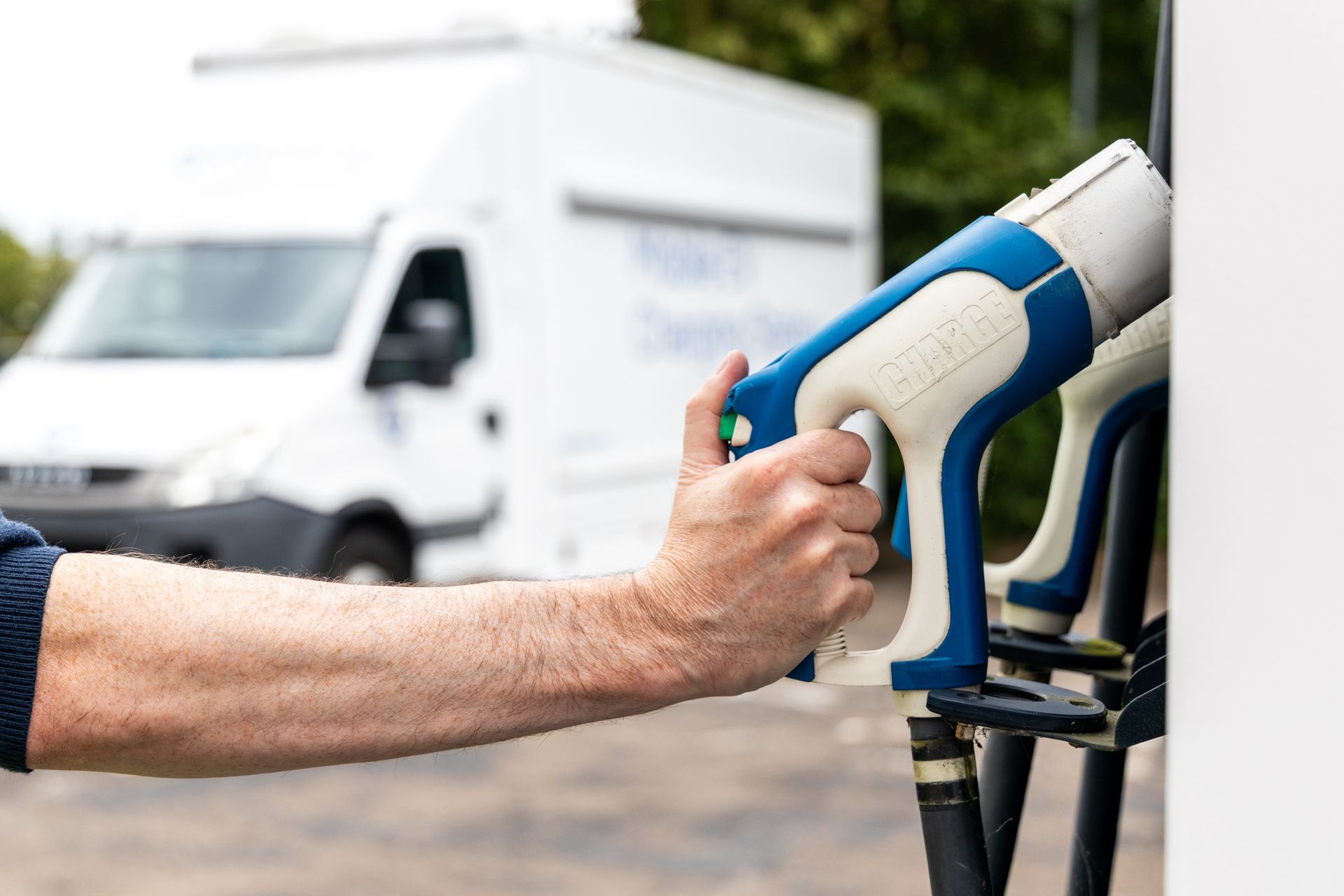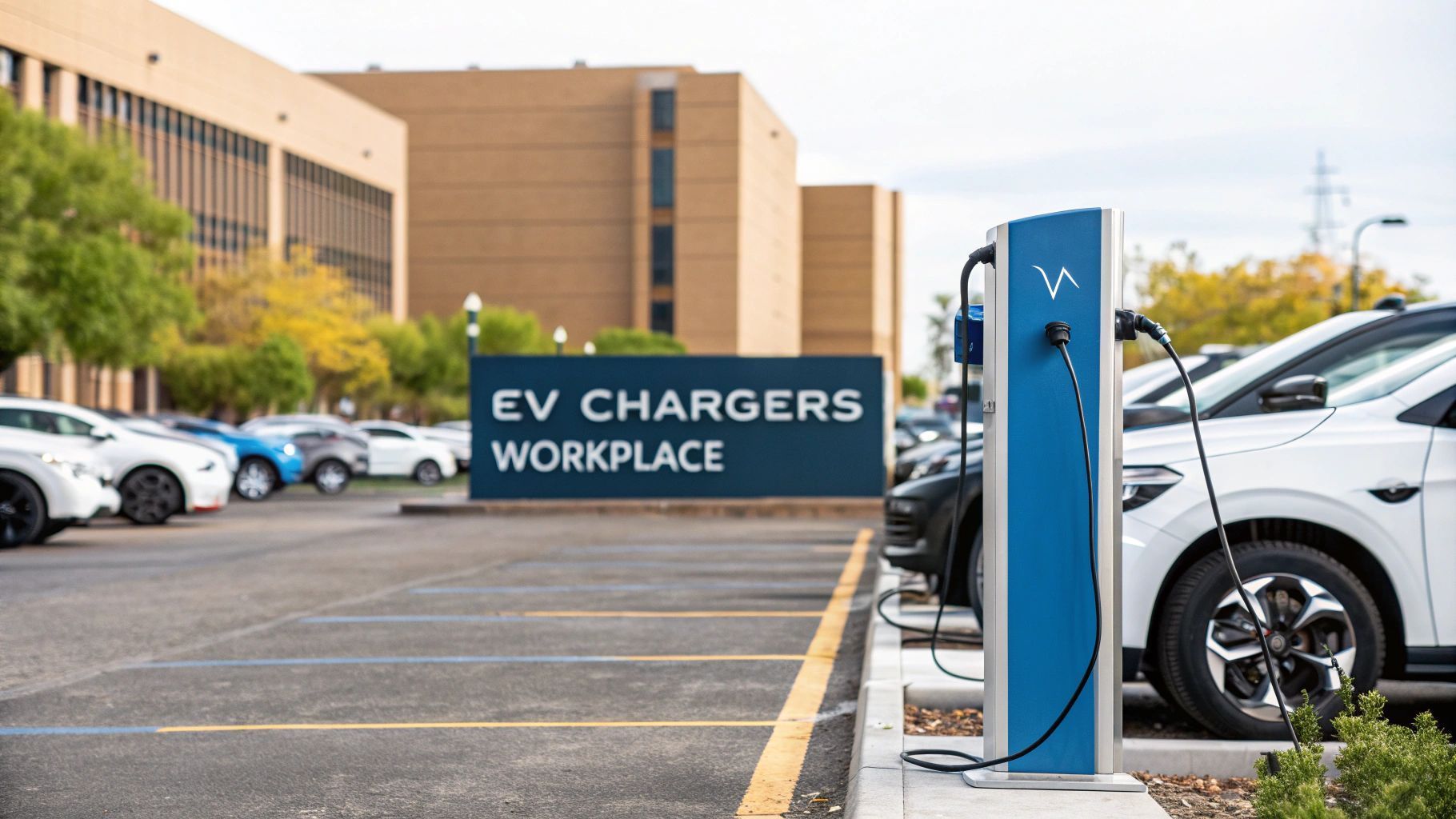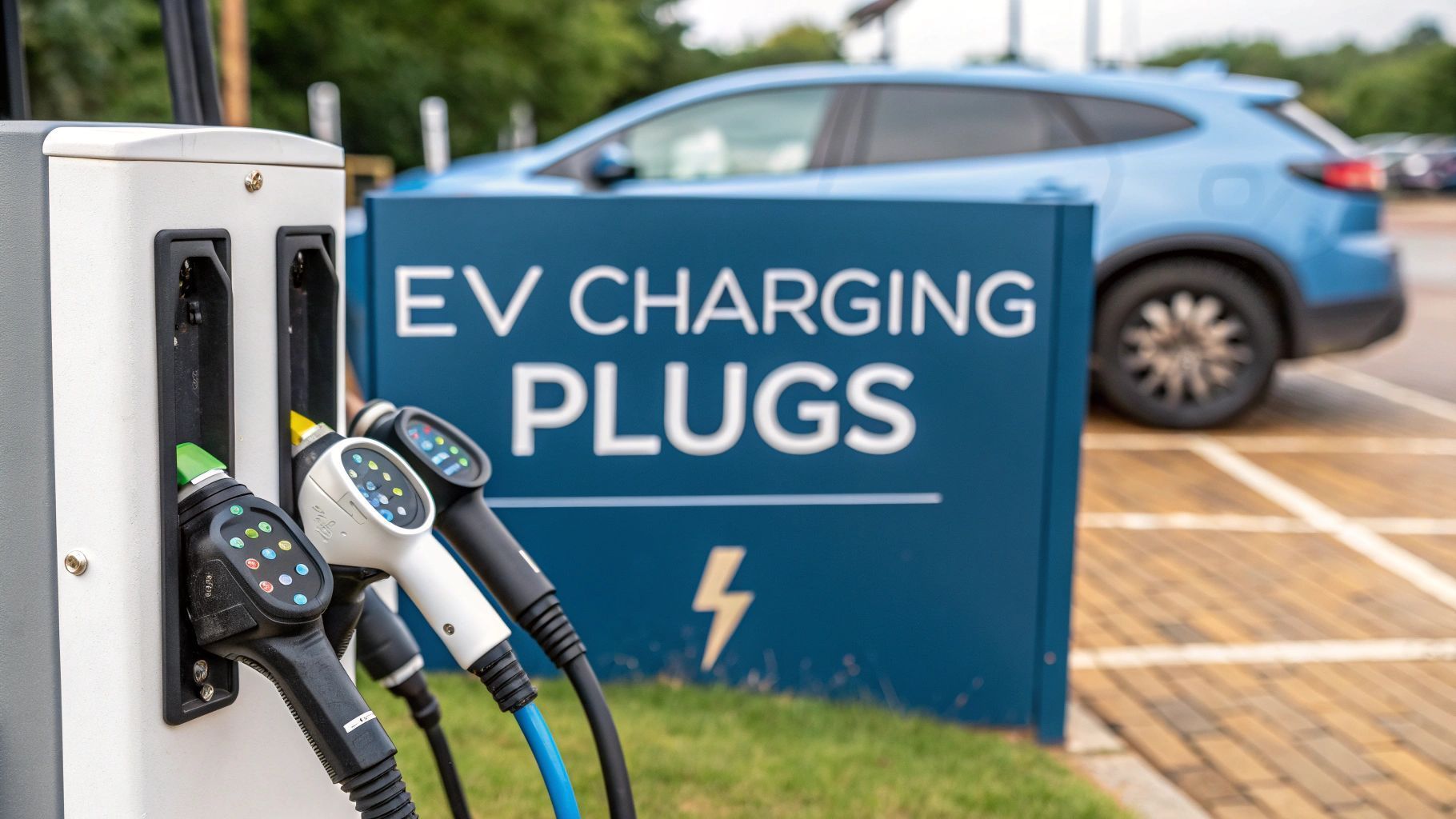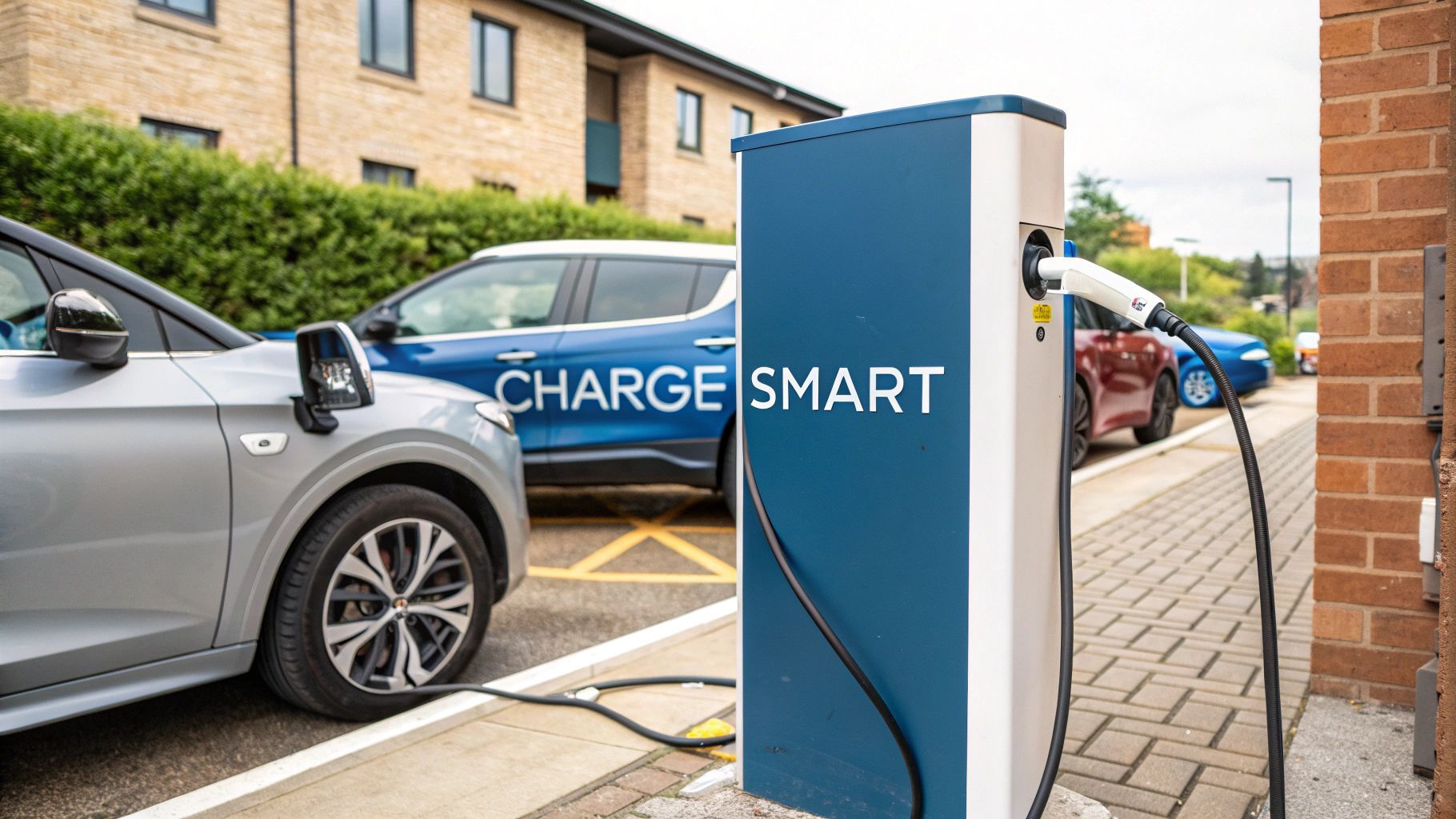What Does Kilowatt Hour Mean in the UK
Staring at your energy bill and wondering what a ‘kWh’ actually is? You're not alone. In simple terms, a kilowatt-hour (kWh) is the standard unit of energy your supplier uses to measure and charge you for the electricity you’ve used. It might sound a bit technical but it’s really just a way to quantify how much energy you consume over a period of time.
Decoding the Kilowatt-Hour on Your Bill
To really get to grips with what a kilowatt-hour means in practice, it helps to break it down.
Think of your home's electricity supply like water flowing from a tap. The speed of the water is the power , which we measure in kilowatts (kW) . The total amount of water you've collected in a bucket over one hour is the energy , measured in kilowatt-hours (kWh) .
So, a kWh represents the total amount of energy you’ve consumed when you use one kilowatt of power for a full hour. This straightforward relationship between power and time is the foundation of every electricity bill.
The diagram below shows this relationship perfectly—energy (kWh) is simply a product of power (kW) and time.
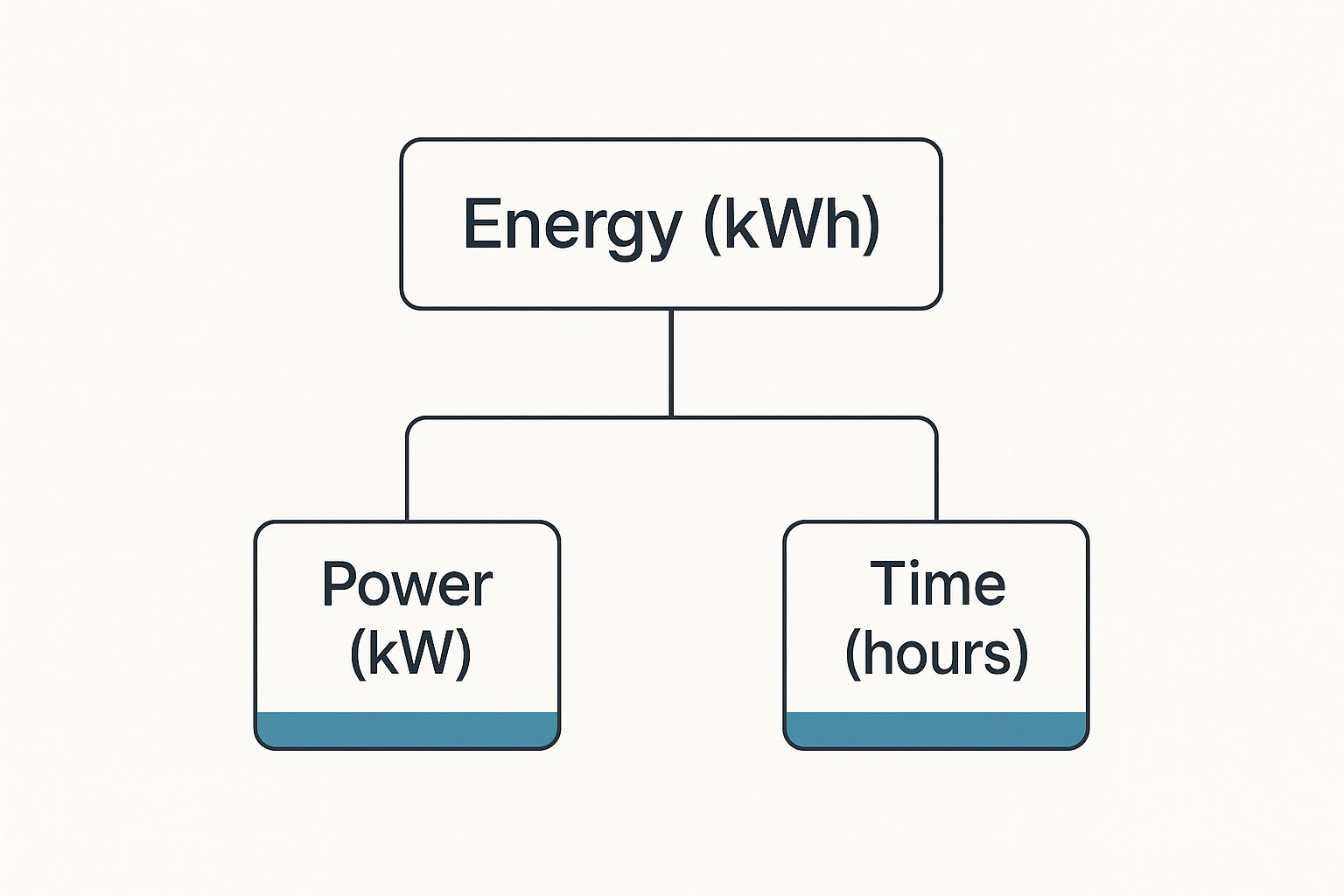
This visualisation makes it clear that a kilowatt-hour isn't a measure of speed. It’s a measure of volume, or total consumption.
To put this into a real-world UK context, running ten 100-watt light bulbs for one hour consumes exactly 1 kWh of energy. It’s easy to see how these units add up across all your appliances. The average household in England, Scotland and Wales uses around 2,700 kWh of electricity each year. For more on this, you can check out Ofgem's latest data on UK energy consumption.
A kilowatt-hour is the billing unit for energy delivered to you by your supplier. It’s what you pay for, not the rate at which you use power.
Kilowatt vs Kilowatt-Hour at a Glance
It's common to mix up kilowatts (kW) and kilowatt-hours (kWh) but they measure two very different things. This table breaks down the key distinctions with a simple analogy to make it stick.
| Concept | Kilowatt (kW) | Kilowatt-Hour (kWh) | Analogy |
|---|---|---|---|
| What it is | A measure of power (the rate of energy use) | A measure of energy (the total amount used) | How fast you're driving |
| Use Case | Describes an appliance's power demand | Measures total electricity consumption over time | How far you've driven |
Ultimately, kW tells you how much power an appliance needs right now, while kWh tells you how much energy it has actually used over a set period. Understanding this difference is key to managing your energy costs, especially when it comes to charging an electric vehicle.
Understanding Power vs Energy
To really get your head around what a kilowatt-hour is, we first need to clear something up: the difference between a kilowatt ( kW ) and a kilowatt-hour ( kWh ). People often use them interchangeably but they measure two completely different things. Nailing this distinction is the key to understanding your electricity bill and making smarter choices about your energy use.
Let's think about it with a simple car analogy.
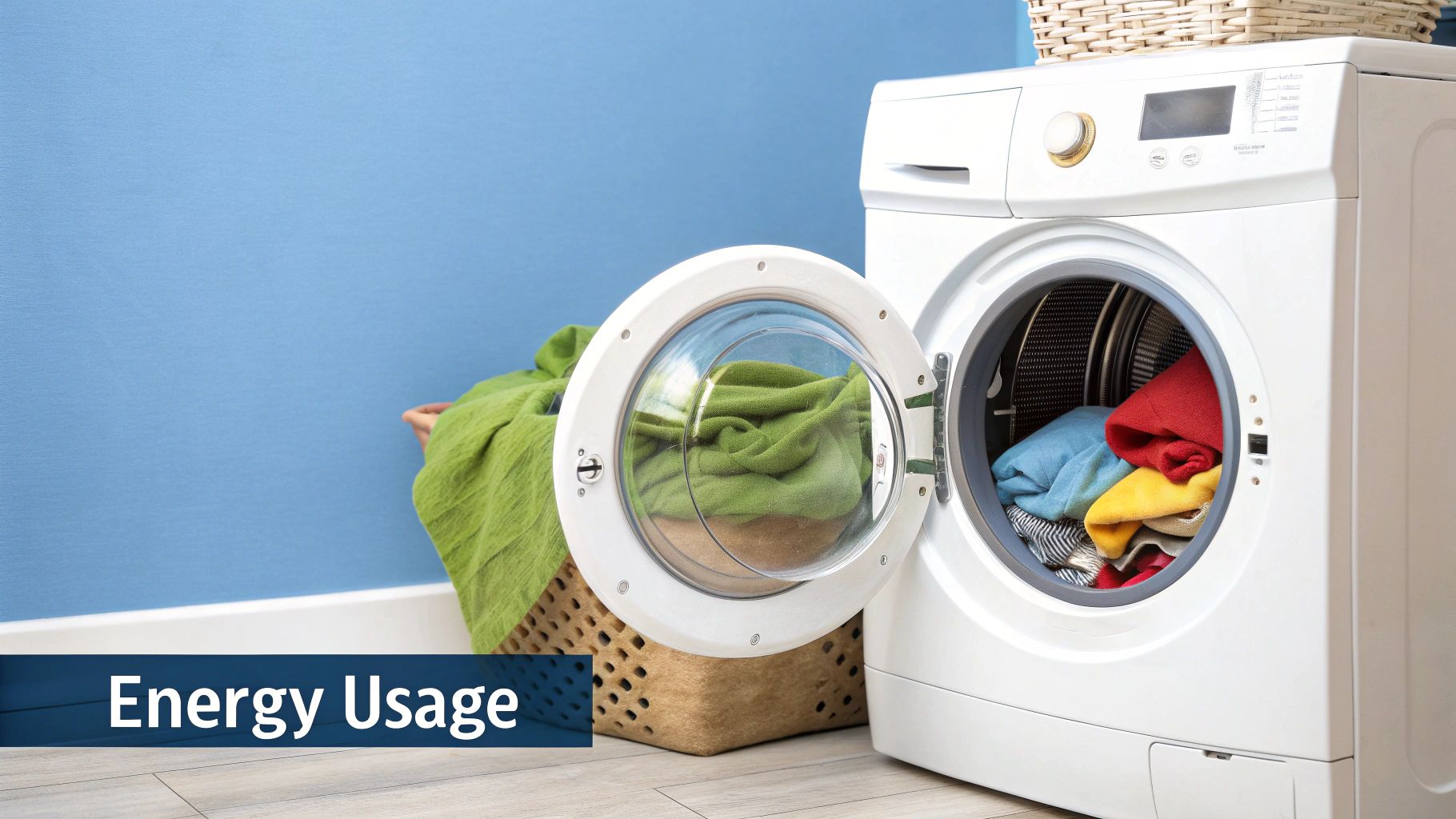
Power , measured in kilowatts (kW) , is like a car’s speed. It’s a snapshot showing how fast energy is being used at any given moment. A powerful appliance, like a 2 kW electric heater, is like a sports car accelerating hard—it demands a lot of power instantly.
From Speed to Distance
Energy , on the other hand, is measured in kilowatt-hours (kWh) . This is the total distance that car has travelled. It’s the total amount of power you’ve used over a period of time and it’s what you actually get billed for.
That powerful 2 kW heater might feel like a gas-guzzler but if you only switch it on for one hour, it uses 2 kWh of energy. Now, consider a low-power television that only draws 0.1 kW . That’s more like a slow and steady family car.
But here’s the twist. If you leave that TV on for 20 hours, it will have used the exact same amount of energy as the heater: 2 kWh . This simple example shows how both power and time are crucial ingredients in your final electricity bill.
The core idea is simple: Power (kW) is how fast you use electricity and Energy (kWh) is how much you’ve used in total.
Just looking at an appliance's power rating can be misleading. A device with a low power draw that’s left on for a long time can easily use more energy than a high-power device used only briefly. This is exactly why knowing what a kilowatt-hour means is so vital for managing your costs.
Calculating Your Own Energy Costs
Knowing the theory is one thing but putting it into practice is where you can really start to save money. Understanding the kilowatt-hour is the key to becoming your own energy auditor, letting you see exactly how much specific appliances contribute to your monthly bill.
The formula itself is surprisingly straightforward.
Appliance Power (kW) × Hours of Use = Energy Consumed (kWh)
This simple calculation gives you the power to see exactly what you’re using. Let's walk through a real-world example with one of the most common appliances in any UK home.
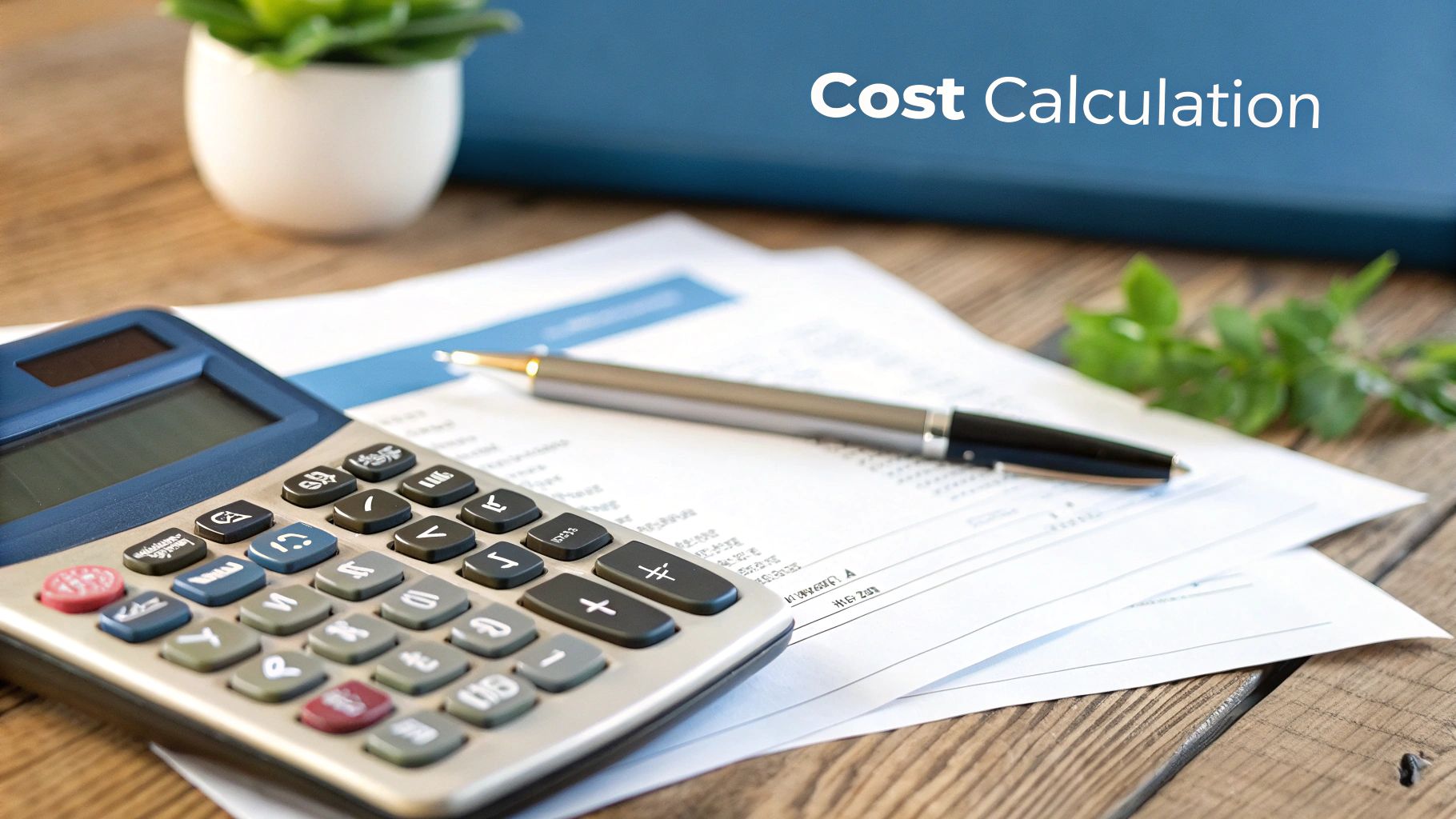
A Practical Example: The Washing Machine
Picture this: your washing machine has a power rating of 2,000 watts and a typical wash cycle runs for one hour . First, we need to convert that power rating from watts into kilowatts. Since there are 1,000 watts in a kilowatt, you just divide by 1,000.
- Power Conversion : 2,000 watts / 1,000 = 2 kW
Now, we can pop that figure into our formula to find out how much energy the cycle used.
- Calculation : 2 kW × 1 hour = 2 kWh
So, that single load of laundry consumed 2 kWh of electricity. To figure out the cost, just grab your latest energy bill and look for the ‘price per kWh’ your supplier charges. If your rate is 25p per kWh , the final step is simple.
- Cost : 2 kWh × £0.25 = £0.50
Your load of washing cost you exactly 50p . This same principle applies to everything from your television to charging an electric vehicle. For those thinking about switching to an EV, understanding your costs is vital, especially if you can’t install a home charger. Learning about https://www.zapme.biz/how-zapme-supports-ev-drivers-without-home-charging-options provides more insight into managing these expenses on the go.
If you want to dig deeper into reducing your overall consumption and calculating potential savings, a complete guide to energy efficiency for buildings can be incredibly insightful. Applying this knowledge is the first step towards spotting which devices are driving up your bill and making smarter choices.
Seeing kWh in Your Daily Life
The idea of a kilowatt-hour can feel a bit abstract when it’s just a number on your electricity bill. But once you start noticing it in action around your home, it becomes a tangible, everyday reality. Every time you boil the kettle or run the tumble dryer on a rainy day, you’re using kWhs and understanding this helps build a clearer picture of your household’s energy footprint.
While every appliance adds up, for many UK households the single biggest new energy consumer is the electric vehicle. For any EV driver, getting to grips with what a kWh actually means is crucial – it’s the key to understanding both your running costs and your car’s real-world range.
Kilowatt-Hours and Your Electric Vehicle
An electric car’s battery capacity is measured in kilowatt-hours (kWh) . Think of it like a fuel tank. A vehicle with a 75 kWh battery can store 75 kWh of energy, just as a petrol car might have a 75-litre tank. This number is the single biggest factor determining your car’s range – how far it can travel on a single charge.
The charger's speed, measured in kilowatts (kW), tells you how quickly you can fill that "tank". A 50 kW rapid charger, for example, can theoretically add 50 kWh of energy to your battery in one hour. This becomes vital on a long journey when you need to get back on the road quickly. To get a better sense of the options out there, have a look at our guide to understanding the UK’s public EV charging point networks.
Knowing your car's kWh capacity and the kW speed of a charger allows you to accurately predict charging times and plan your trips with confidence, removing the guesswork from driving an EV.
To put all this into context, here’s a quick look at how different items, including EVs, consume energy.
Typical kWh Consumption of Household Items and EVs
| Item/Appliance | Average Power Rating (kW) | Typical Usage Duration | Energy Consumed (kWh) |
|---|---|---|---|
| Electric Kettle | 2.5 kW | 3 minutes (0.05 hours) | 0.125 kWh |
| Tumble Dryer | 4.0 kW | 1 hour | 4.0 kWh |
| Laptop | 0.05 kW | 8 hours | 0.4 kWh |
| EV Home Charger | 7.4 kW | 1 hour | 7.4 kWh |
| EV Public Charger | 50 kW | 1 hour | 50 kWh |
As the table shows, charging an EV is a completely different scale of energy use compared to household appliances, which is why understanding kWh is so important for managing costs.
Interestingly, overall UK electricity consumption has been falling for nearly two decades, largely thanks to more efficient technology. After peaking in 2005 at 357 terawatt-hours (TWh) , it dropped by roughly 25% to 266 TWh in 2023. This is mirrored in personal usage, with the average consumption per person falling from around 5,800 kWh in 2000 to 4,813 kWh in 2022. You can discover more insights about UK electricity trends on Statista.
This wider trend towards efficiency makes understanding your own consumption even more relevant. Every kilowatt-hour you save has a real impact.
The Business of Selling Kilowatt Hours
Understanding the kilowatt-hour isn't just about saving money on your own bills; it's a direct route to making it. As electric vehicles become a common sight across the UK, new business models are taking shape and mobile EV charging is emerging as a particularly smart and flexible opportunity.
This approach turns the humble kWh into a commodity you can sell wherever it’s needed most.
The business model is beautifully simple: buy energy low and sell it high. Imagine buying electricity from the grid overnight at a cheap off-peak rate, maybe 15p per kWh , and storing it in a mobile charging unit.
The next day, you can sell that same energy to an EV driver in a busy city centre car park or at a retail park for a premium, say 65p per kWh . The difference is your gross profit.

Turning Kilowatt Hours into Profit
Let’s run the numbers to see how this works in the real world. A price difference of 50p per kWh creates a very healthy profit margin. Even on a small scale, the earnings add up quickly.
Selling just 50 kWh in a day—enough to fully charge a standard electric family car—could net you a gross profit of £25 . This model lets you completely bypass the huge upfront costs and planning headaches that come with installing fixed charging points. You can go straight to where the demand is, whether that's an office park, a festival or a block of flats.
The real power of mobile charging is its agility. Operators aren't tied to one spot; they can serve multiple customers in different places, maximising their unit's uptime and profitability.
This flexibility is a massive advantage in the fast-growing UK electric vehicle market. New opportunities are popping up all the time and mobile charging operators are perfectly placed to meet that demand. For a deeper look into this model, you can learn more about how Energy as a Service offers new opportunities to businesses and is reshaping EV recharging.
The Advantages of a Mobile Model
A mobile charging business has several clear wins over traditional, fixed infrastructure:
- Lower Start-up Costs: You avoid the eye-watering expense of groundworks, grid connections and long-term site leases.
- Targeted Service: You can go where the EVs are, whether that’s busy retail parks, fleet depots or residential streets with no off-street parking.
- Scalability: It's easy to start with one unit and then expand your fleet as your customer base grows.
This approach offers a direct and efficient way to profit from the ongoing electric transition, one kilowatt-hour at a time.
So, What Does This Mean for a Mobile Charging Business?
It’s one thing to understand the technical side of kilowatt-hours but what does it mean in the real world? For businesses in the mobile EV charging space, it all boils down to profit. Let's break down some common questions and get straight to the numbers.
The entire business model is built on a simple economic principle: buy low, sell high. A savvy mobile operator can top up their charging units with electricity during off-peak hours for as little as 15p per kWh . They can then sell that same energy on demand, at a premium, wherever drivers need it most.
It’s a straightforward and powerful way to turn energy into revenue.
How Much Money Can an Operator Make?
The profit potential is tied directly to the number of kilowatt-hours you can sell. It’s a simple volume game. For example, if you buy your energy at 15p and sell it at 65p per kWh , you’re making a clean 50p profit on every single unit of energy your charger delivers.
Let’s imagine a typical day:
- Energy Sold: 50 kWh (enough to give one average EV a full charge).
- Profit per kWh: £0.50.
- Daily Gross Profit: 50 kWh x £0.50 = £25.00 .
Now, scale that up. A dedicated operator who can service several vehicles a day is looking at a very healthy income stream. The magic lies in taking the energy to where it's most needed and valued, turning kWh into cash.
The real advantage is being untethered from a fixed location. Mobile operators can target high-demand areas like retail parks, event venues or residential streets without driveways, maximising their sales and daily profits.
This agility is what sets a mobile model apart from static charging points. You skip the expensive groundworks and long-term site leases. Instead, you get the flexibility to go where the market is, lowering the barrier to entry and allowing entrepreneurs to tap into the growing EV market with a much smaller initial investment.
Ready to turn kilowatt-hours into a profitable business? ZAPME offers cutting-edge mobile EV charging solutions designed to help you succeed. Explore our range of products at https://www.zapme.biz.

